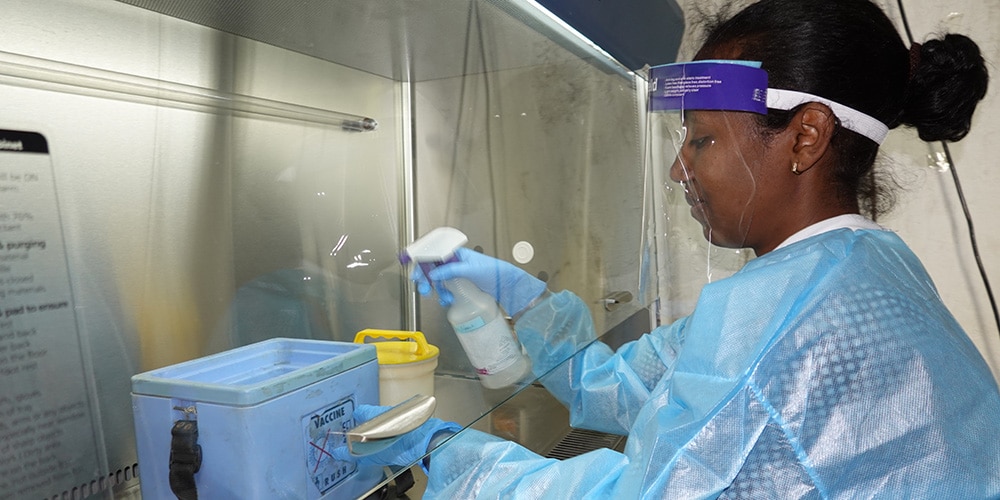CDC in Ethiopia

A laboratory worker simulates specimen inactivation during an Ebola Laboratory Preparedness Training at the Ethiopian Public Health Institute. Photo by Yonathan Alemu/CDC
The Centers for Disease Control and Prevention (CDC) established an office in Ethiopia in 2001. CDC works closely with Ethiopia’s Ministry of Health (MOH) and other partners to address HIV, tuberculosis, malaria, and other infectious diseases. CDC also supports development of workforce capacity and health systems strengthening. CDC provides technical support to meet national and international goals to eradicate polio, eliminate measles, and strengthen the national immunization program in Ethiopia.
Global Health Security
CDC’s global health security efforts in Ethiopia help enhance the country’s ability to prevent, detect, and respond to infectious disease outbreaks before they become epidemics that could affect global populations. For example, CDC supports the national and regional Public Health Emergency Operations Centers (PHEOC) to effectively respond to outbreaks. During the COVID-19 pandemic, CDC worked with the MOH, Ethiopia Public Health Institute (EPHI), and other public health partners to ensure broad access to diagnostic services and prevent further spread of disease. Such partnership is exemplified by CDC experts who work closely with EPHI on the national emergency COVID-19 response team. CDC also helps strengthen and expand laboratory testing, epidemiology and surveillance, and infection prevention and control.
In 2017, CDC established an antimicrobial resistance (AMR) surveillance system in collaboration with EPHI, Ohio State University, the American Society for Microbiology, regional health bureaus, and health facilities. This system covers 16 facilities in nearly every region
Since 2014, CDC has supported Ethiopia’s EOCs to respond to a range of public health emergencies, including: COVID-19, cholera, measles, severe acute malnutrition, dengue fever, chikungunya, scabies, drought-related public health issues, flooding, and internal displacement due to socio-political conflicts
HIV/AIDS and Tuberculosis (TB)
Through the U.S. President’s Emergency Plan for AIDS Relief (PEPFAR), CDC partners with Ethiopia to provide comprehensive HIV treatment and prevention, address HIV/TB co-infection, screen for and treat cervical cancer, and strengthen laboratory systems. CDC supports Ethiopia’s efforts to reach HIV epidemic control by 2030 through enhanced case-finding, linkage to treatment, viral load testing, and continued adherence and retention of patients on antiretroviral treatment (ART). CDC also partners with EPHI to strengthen disease detection, surveillance, and response functions and implement an integrated strategic plan for laboratories. Since TB is a leading cause of death for people living with HIV, CDC also works to scale up TB programs and activities, such as TB preventive therapy.
More than 26,000 people received positive HIV test results in 2022. This represents a 6% decrease in cases compared to 2021
As of late September 2022, more than 458,000 men, women, and children receive ART in Ethiopia
As of 2022, more than 11,000 pregnant women with HIV receive ART to reduce the risk of mother-to-child transmission of HIV
In 2022, 95% of TB patients on treatment had an HIV test result on file. Nearly 5,000 people with HIV/TB coinfection were linked to comprehensive treatment services at CDC-supported facilities
TB Preventive Therapy (TPT) coverage among people receiving ART reached 87% in December 2022. In 2021 alone, more than 34,000 (82%) people with HIV who receive TPT completed their treatment
In 2021, CDC introduced new cervical cancer screening and treatment technology in Ethiopia, which led to cancer screening for approximately 140,000 women living with HIV. 88% of women with positive precancerous lesions are now receiving treatment
Immunization
CDC’s global immunization experts partner with Ethiopia to eradicate polio, eliminate measles, develop evidence-based programs, and strengthen the national routine immunization program. CDC provides technical support to introduce new vaccines and conduct operational research on access, utilization, and barriers to vaccine delivery. CDC also assists with vaccine-preventable disease outbreak investigations, surveillance, monitoring and evaluation, and supplementary immunization activities.
In 2022, CDC experts supported multiple vaccine-preventable disease response activities, including measles, polio, and COVID-19 vaccination campaigns
CDC helped pilot the Hepatitis B vaccine, which is given at birth to prevent maternal-to-child transmission, to assess the feasibility of its use in Ethiopia
CDC helped establish a sentinel surveillance site to monitor for adverse events following immunization against COVID-19
CDC generated evidence on potential barriers to young children receiving a second dose of measles vaccine and evaluated the effects of using smaller vaccine vials to address concerns about wasted supply
Field Epidemiology Training Program (FETP)
FETP strengthens the capacity of public health officers to detect, respond, and control public health emergencies at the source. In 2009, CDC helped establish the Ethiopia FETP, which consists of three levels of training: frontline, intermediate, and advanced. Participants learn to gather critical data and turn it into evidence-based action. FETP graduates are critical to preparedness and response efforts, especially as they lead and support the national PHEOC incident management structure for COVID-19.
From 2009-2022, more than 600 trainees graduated from FETP-Advanced between 2009 and 2022
19 epidemiologists graduated from FETP-Intermediate since it was established in December 2021
More than 1,000 district surveillance officers graduated from FETP-Frontline between 2017 and 2022
FETP participants have responded to hundreds of outbreaks since 2009, including: anthrax, malaria, cholera, yellow fever, pertussis, guinea worm, vaccine derived polio virus, and measles
Malaria
Through the U.S. President’s Malaria Initiative (PMI), CDC assigned a resident advisor to help implement malaria prevention and control activities in Ethiopia. CDC’s technical support includes investigation of insecticide resistance and research on durability of long-lasting insecticide-treated bed nets. With the U.S. Government’s support, Ethiopia is close to achieving malaria elimination in more than 230 districts.
Through PMI, more than 47 million long lasting insecticide-treated bed nets were procured and distributed across the country since 2008
- 11 U.S. Assignees
- 69 Locally Employed
- Population: > 123.4 million
- Per capita income: $2,590
- Life expectancy: F 68 / M 62 years
- Infant mortality rate: 47/1,000 live births
Sources:
Sources: Population Reference Bureau 2022, Ethiopia